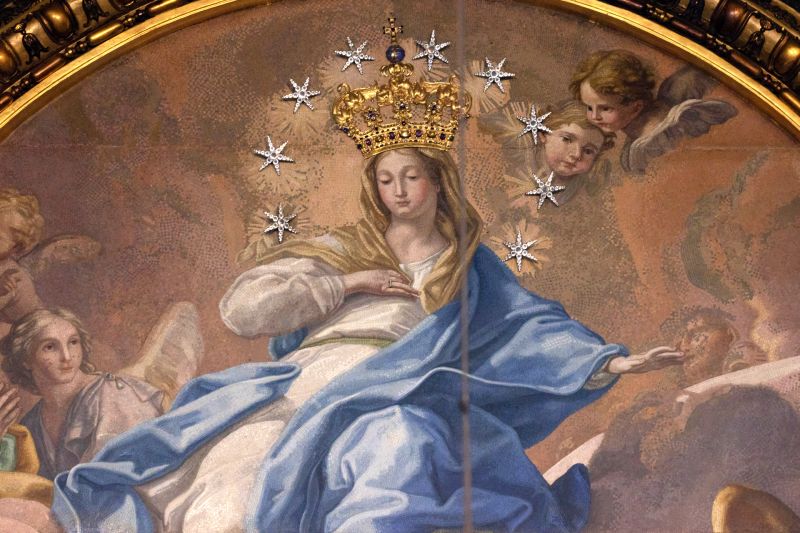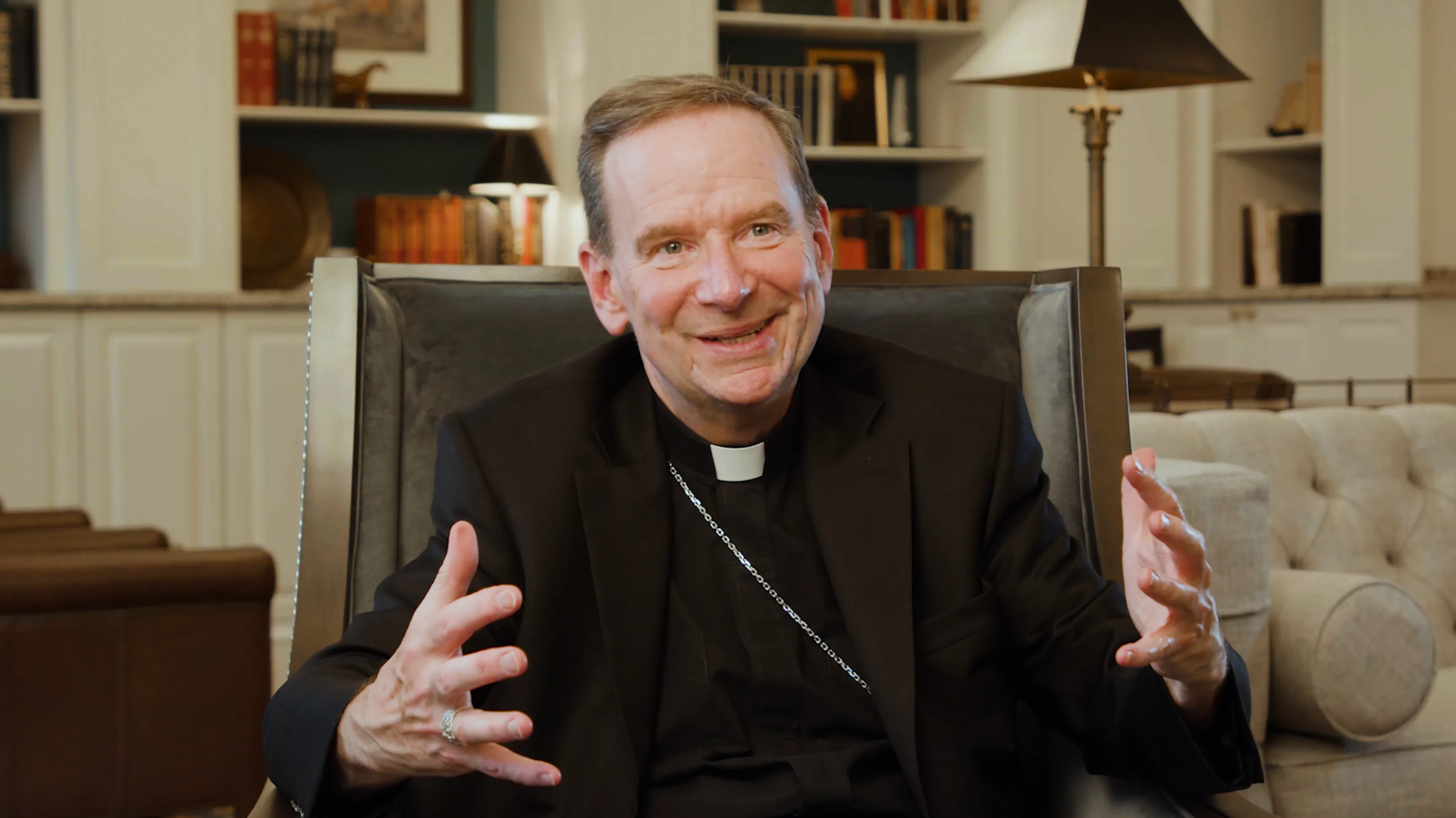
The most important “deals” in history were struck on Calvary through some truly admirable exchanges, always redounding to the benefit of the individual believer. This is especially true in our present reflection.
The Mother of Christ is given into the care of the Beloved Disciple. On the surface, it seems that Jesus is merely ensuring His Mother’s well-being after His death. A closer look, however, suggests that the disciple is the one who is really being cared for.
Throughout the New Testament we find references to Mary. In fact, at every key juncture in Our Lord’s life, we see Mary on the horizon. When God began His plan for our redemption, He sent to Nazareth an angel, who hailed a woman as “highly favored” or “full of grace” to be the human partner in this divine task (cf. Luke 1:28).
When the Babe was born in Bethlehem, He came forth into our world not from heaven but from the womb of the Virgin Mary (cf. Luke 2:7). As the Child was presented to the Almighty in the Temple at Jerusalem on the fortieth day, the old prophet Simeon singled out His Mother Mary for special mention as a woman destined to be the Mother of Sorrows (cf. Luke 2:35). Twelve years later, after another Temple visit, the Boy Jesus returned with His Mother and foster father to Nazareth and was subject to them (cf. Luke 2:51).
It was Mary who prodded her Son into action at Cana to work His first miracle, launching Him on His public ministry (cf. Jn 2:3f). And it was Mary who stood by His side at the foot of the cross and was given to John as the Mother of the Church (cf. Jn 19:25f), to use the beautiful phrase of Pope Paul VI. Finally, as the Church was waiting to be born in the Upper Room, while the disciples prayed for the Pentecost gift of the Spirit, Luke tells us that Mary was in their midst (cf. Acts 1:14).
Three passages of Johannine origin should be pondered in greater depth, two of them already noted in passing. Most serious Scripture commentators agree that John has the most highly developed theology and literary style of all the writers of the New Testament. The structure of John’s Gospel is a masterpiece in which even the arrangement of material and the introduction of certain people advance the theological agenda.
For example, the deliberately unnamed “Beloved Disciple” is generally regarded to stand as a symbol for the ideal Christian in every age who stays with Jesus to the end – and beyond. Another figure of prominence, however, is the Mother of the Lord, who appears only twice (unnamed also and simply addressed by her Son as “woman” – to establish the connection between her and the original woman, the mother of all the living, in Genesis).
The Lord’s earthly ministry ended on Calvary with the Beloved Disciple and the “woman” brought into a unique relationship with each other by the dying Christ. The beloved disciple, representative of every committed Christian, in that moment was given the Mother of Christ to be his own mother. The physical maternity of Mary was thus extended to include now a spiritual motherhood of the Church, her Son’s brothers and sisters. Just as she brought Christ’s physical Body into the world, now she would play a role on behalf of His mystical Body, the Church. Mary did not ask for this role; it was nothing less than her divine Son’s dying wish for her and for His Church.
The theme of the woman who is the Mother of the Church reaches a climax in Revelation 12. Readers are brought up short as they try to unravel the symbolism. Is the woman, laboring to give birth, Mary or the Church? The author of Revelation was so skillful a writer that both interpretations are possible, and both are probably intended. Catholics see the parallels as more than a happy coincidence, for the roles of Mary and the Church intersect at many points.
The class of 1954 of Seton Hall University erected a shrine to the Blessed Mother as their graduation gift during that Marian Year. As a young seminarian, passing it daily more than a decade later, I was continually struck by the simple, manly, yet profound devotion of the inscription: Filii ad Matrem (“Sons to the Mother”). That captures the essence of a healthy and scripturally based regard for the Mother of God, because it links together all the necessary ingredients: the Son, the Mother, the Son’s Church which shares His Mother.
When the Disciple agreed to “take her into his care,” he did himself (and all who would succeed him as disciples) a far greater favor than he did her. In the plan of Providence, his action became the occasion for joining inseparably the Son with His brothers and sisters, all of whom can lay claim to a common Mother, “who occupies a place in the Church which is the highest after Christ and also closest to us” (Lumen Gentium, n. 54).
(Editor’s note: This is the third of seven reflections by Fr. Stravinskas on the Seven Last Words, leading up to Good Friday. They were originally preached on Good Friday 2017 at the “Tre Ore” at Holy Innocents Church, Manhattan.)
• “Seven Last Words from the Cross: ‘Father, forgive them…’” (March 23, 2018)
• “Seven Last Words from the Cross: ‘This day you will be with Me in paradise’” (March 24, 2018)

If you value the news and views Catholic World Report provides, please consider donating to support our efforts. Your contribution will help us continue to make CWR available to all readers worldwide for free, without a subscription. Thank you for your generosity!
Click here for more information on donating to CWR. Click here to sign up for our newsletter.









Reverend Peter M.J. Stravinskas
Seven Last Words from the Cross: “Woman, Behold Your Son”
The Apostles James and John, brothers, sons of Zebedee had a mother who made a proud request of Christ. Matthew 20:20-28. Today 25 July is the feast day of St James the Apostle who did drink the cup of Christ.
There is another way to view the words, “Woman behold your son”.
Perhaps the mother of the sons of Zebedee died before Christ’s crucifixion. Christ replaced St. John’s mother with humble Mary so that John might learn that “he who wants to be first among you must be your slave, just as the Son of Man came not to be served but to serve.”
St John was proud when he jointly replied “we can” to Christ. Matthew 20:20-28. He was still proud when he wrote his gospel, describing himself as the “beloved disciple”.
But he must have humbled himself later on.
Nor did he drink the cup of Christ like his brother St. James.
Perhaps he was taught humility from his new mother, Mary,the daughter of Zion (giver of the Temple).